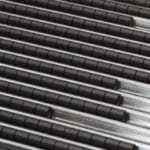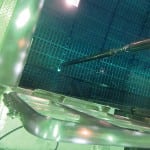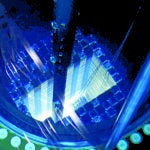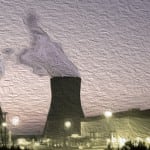The U.S. is pouring funding into developing new fuel technology for advanced nuclear reactors in a bid to help the flagging industry. On April 27, it awarded General Atomics (GA) $3.2 million for two projects that the San Diego, California-based company is developing, including an accident tolerant fuel (ATF) solution that the company says is “truly revolutionary.”
The funding, for which GA will provide a cost share, is aimed to advance development and licensing of new reactor fuel that features silicon carbide (SiC) composite fuel cladding containing uranium carbide (UC) fuel pellets. One project, being conducted in collaboration with the Oak Ridge National Laboratory and the University of Tennessee with total funding of $2,763,744, will combine advanced computer modeling and simulation with new microcapsule irradiation to establish techniques that “substantially reduce the time and expense required to qualify new fuels,” the company said. The second project, funded at a total of $475,819, would back the pre-application license review of SiC-UC fuel by the Nuclear Regulatory Commission, allowing the company to develop an efficient roadmap for formal regulatory qualification.
Nuclear Prospects for a 100-Year-Old Compound
General Atomics told POWER in April that it has been working with SiC—which it recently furnished with the trade name, “SiGA”—since the 1960s. SiC ceramic, it noted, has been used for a variety of industrial purposes for more than 100 years, and owing to its high hardness and ability to withstand extremely high temperatures, the composite has long been considered ideal for cutting tools, refractory components, and high-power electrical systems.
“However, its brittleness in pure form has limited its use as a structural material,” GA explained. In the 1990s, researchers discovered that monolithic SiC can be significantly toughened by reinforcing it with flexible SiC fibers, forming a combined material known as a ceramic matrix composite (CMC). “In a CMC, these fibers provide reinforcement similar to how steel rebar reinforces concrete. CMCs have been explored for a variety of high-temperature applications (mainly in aerospace), but manufacturing challenges and problems with joining composite components have slowed deployment,” it said (Figure 5).
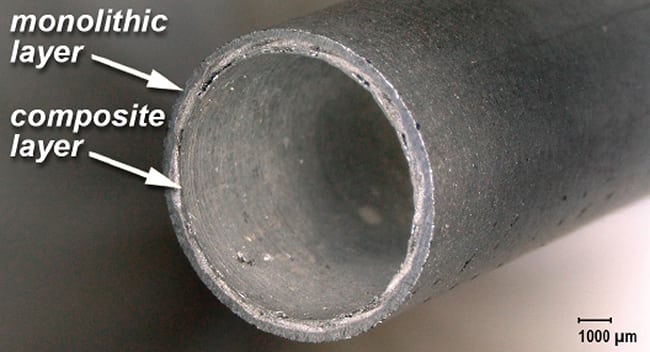
GA’s experience with SiC began with SiC-coated TRISO fuel particles for the Fort St. Vrain reactor. The facility in Colorado operated as a nuclear plant between 1979 and 1989. After it was decommissioned, Fort St. Vrain was converted to a natural gas plant that is today owned by Xcel Energy. In the late 2000s, GA stepped up its research on SiC CMCs for nuclear fuel cladding while developing its advanced high-temperature gas-cooled reactor (HTGR) design, the Energy Multiplier Module (EM2). EM2 is a small modular helium-cooled fast reactor that could offer dramatic improvements in cost, safety, and non-proliferation while reducing waste production and enabling the use of multiple fuel types, including spent reactor fuel, GA said. “Because EM2 is designed to operate at temperatures up to 850C, it requires fuel rods that can safely withstand such conditions. SiC CMC was identified as the best solution,” it added.
The technology has gained a renewed relevance owing to the nuclear industry’s commitment to developing ATFs in a timely way. (For more, see “Accident-Tolerant Fuels Could Be a Boon for Nuclear Industry” in POWER’s April 2018 issue.) As GA noted, interest in fuel rods that can tolerate extreme temperatures surged after the Fukushima accident in 2011.
“One of the elements that made this disaster so severe is related to the zirconium-alloy fuel rod cladding used in current reactor cores. At Fukushima, after the water boiled away and the core overheated, the cladding reacted violently with high-temperature steam in the reactor vessel. This highly exothermic reaction between zirconium and the oxygen in the steam added to the thermal energy already present from decay heat and also generated explosive hydrogen. This was one of the main factors that caused the cores to melt down and led to the hydrogen explosions that breached the reactor’s containment,” it said.
ATF Advancement: Evolutionary v. Revolutionary
Today, under the Department of Energy’s ATF program, which Congress launched in 2012, several nuclear fuel makers are developing several concepts for ATF fuel pellet and cladding materials, and testing is underway or scheduled at four nuclear units in the U.S. GA leveraged its work on EM2 to successfully partner with Westinghouse in proposing a SiC-based ATF solution. But its solution stands out from other efforts, the company said.
While other ATF initiatives are exploring evolutionary advances, such as coated metals or new alloys, SiC is said to offer “a truly revolutionary ATF technology.” GA claims SiC CMCs can withstand far harsher conditions than metal fuel rods. Tests have shown that SiC-SiC cladding can retain its strength at temperatures greater than 3,000F (1,700C), more than twice the tolerance of zirconium alloys. The material has also survived immersion in water from temperatures as high as 1,200C. Additionally, SiC is much more chemically stable, virtually eliminating the risk of hydrogen explosions during loss-of-cooling accidents, according to the company.
In tandem, GA is developing a robust and durable end joint seal to keep fission products safely contained during normal operation. Using dissimilar materials to bond SiC joints typically results in cracking under irradiation, the company noted, so it created a high-purity stoichiometric SiC bonding method, known as GA-HSiC, to seal the fuel rod end joints. “Recent tests at Oak Ridge National Laboratory demonstrated that both the SiC CMC and the HSiC joints retained their integrity under irradiation and showed no signs of cracking that would release fission products,” it said.
Asked how ATF fuels—and specifically GA’s SiC composite SiGA—would improve cost efficiency, the company explained that SiGA cladding improves the neutron efficiency of the core, “meaning more neutrons are available to sustain the fission reaction.” Combined with advanced uranium silicide and uranium carbide fuels, SiGA cladding also allows for higher fuel density, resulting in higher burn-up and longer refueling cycles. That translates to reduced fuel costs.
“The combination of SiGA cladding and advanced fuels will also add margin to normal operation, anticipated operational occurrences, design-basis, and beyond-design-basis accidents. This added margin means greater operational flexibility and the opportunity for plant uprates,” the company added. “While it is difficult to put exact numbers on this without testing under operational conditions, the bottom line is that a shift to ATF will mean increased plant revenue, perhaps significantly so.”
For now, owing to the notable benefits in safety, efficiency, and operating costs offered by GA’s SiC-SiC ATF over current metal fuel rod designs, the company anticipates the technology will be widely sought commercially. To meet future commercial demand, GA is developing a proprietary mass-production process for high-purity SiC CMCs. “Once completed, this process could open up substantial possibilities in nuclear, defense and aerospace applications in addition to ATF,” it said.







